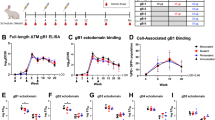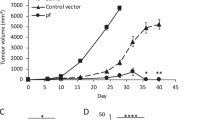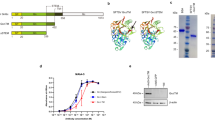Abstract
Intravascular plasmid DNA (pDNA) vaccine encoding herpes simplex virus type 1 (HSV-1) glycoprotein B (gB) effectively induces prophylactic immunity against lethal HSV-1 infection in mice. We investigated whether the vaccine potency is further improved by coadministration of cytokine genes together with a low dose of genetic vaccine. pDNA encoding IL-12, IL-15, IL-18 or IL-21 was capable of elevating survival rates of HSV-1-infected mice when coinjected with 1 μg of gB pDNA, while IL-10 gene delivery failed to affect the effectiveness of the genetic immunization. Although only 17% of mice survived acute HSV infection after the gB pDNA vaccination at a dose of 1 μg, all mice coadministered with 1 μg each of gB and IL-12 pDNAs not only survived the acute infection but also escaped latent infection. In these animals, the neutralizing antibody against HSV-1 was abundantly produced, and CTL activity against the gB antigen was augmented. Coadministration of the gB and IL-12 genes also elevated the serum level of interferon-γ. Adaptive transfer experiments indicated that soluble factors contributed to preventive immunity, while cell components alone were not capable of protecting mice from fatal viral infection. These results strongly suggest potential usefulness of Th1 cytokine genes as effective molecular adjuvants that facilitate specific humoral as well as cellular immune responses elicited by intravascular molecular vaccination.
This is a preview of subscription content, access via your institution
Access options
Subscribe to this journal
Receive 12 print issues and online access
$259.00 per year
only $21.58 per issue
Buy this article
- Purchase on Springer Link
- Instant access to full article PDF
Prices may be subject to local taxes which are calculated during checkout







Similar content being viewed by others
References
Manickan E et al. Genetic immunization against herpes simplex virus. Protection is mediated by CD4+ T lymphocytes. J Immunol 1995; 155: 259–265.
McClements WL, Armstrong ME, Keys RD, Liu MA . Immunization with DNA vaccines encoding glycoprotein D or glycoprotein B, alone or in combination, induces protective immunity in animal models of herpes simplex virus-2 disease. Proc Natl Acad Sci USA 1996; 93: 11414–11420.
Kuklin N et al. Induction of mucosal immunity against herpes simplex virus by plasmid DNA immunization. J Virol 1997; 71: 3138–3145.
Caselli E et al. Mice genetic immunization with plasmid DNA encoding a secreted form of HSV-1 gB induces a protective immune response against herpes simplex virus type 1 infection. Intervirology 2001; 44: 1–7.
Baghian A et al. Protective immunity against lethal HSV-1 challenge in mice by nucleic acid-based immunisation with herpes simplex virus type-1 genes specifying glycoproteins gB and gD. J Med Microbiol 2002; 5: 350–357.
Kriesel JD, Spruance SL, Daynes RA, Araneo BA . Nucleic acid vaccine encoding gD2 protects mice from herpes simplex virus type 2 disease. J Infect Dis 1996; 173: 536–541.
Nass PH, Elkins KL, Weir JP . Antibody response and protective capacity of plasmid vaccines expressing three different herpes simplex virus glycoproteins. J Infect Dis 1998; 178: 611–617.
Nass PH, Elkins KL, Weir JP . Protective immunity against herpes simplex virus generated by DNA vaccination compared to natural infection. Vaccine 2001; 19: 1538–1546.
Lee S et al. Influence of DNA encoding cytokines on systemic and mucosal immunity following genetic vaccination against herpes simplex virus. Microbes Infect 2003; 5: 571–578.
Liu F, Song YK, Liu D . Hydrodynamics-based transfection in animals by systemic administration of plasmid DNA. Gene Therapy 1999; 6: 1258–1266.
Zhang G, Budker V, Wolff JA . High levels of foreign gene expression in hepatocytes after tail vein injections of naked plasmid DNA. Hum Gene Ther 1999; 10: 1735–1737.
Cui FD et al. Highly efficient gene transfer into murine liver achieved by intravenous administration of naked Epstein–Barr virus (EBV)-based plasmid vectors. Gene Therapy 2001; 8: 1508–1513.
Cui FD et al. Intravascular naked DNA vaccine encoding glycoprotein B induces protective humoral and cellular immunity against herpes simplex virus type 1 infection in mice. Gene Therapy 2003; 10: 2059–2066.
Chow YH et al. Development of Th1 and Th2 populations and the nature of immune responses to hepatitis B virus DNA vaccines can be modulated by codelivery of various cytokine genes. J Immunol 1998; 160: 1320–1329.
Kim JJ et al. In vivo engineering of a cellular immune response by coadministration of IL-12 expression vector with a DNA immunogen. J Immunol 1997; 158: 816–826.
Kim JJ et al. Modulation of amplitude and direction of in vivo immune responses by co-administration of cytokine gene expression cassettes with DNA immunogens. Eur J Immunol 1998; 28: 1089–1103.
Kim JJ et al. Cytokine molecular adjuvants modulate immune responses induced by DNA vaccine constructs for HIV-1 and SIV. J Interferon Cytokine Res 1999; 19: 77–84.
Sin JI et al. IL-12 gene as a DNA vaccine adjuvant in a herpes mouse model: IL-12 enhances Th1-type CD4+ T cell-mediated protective immunity against herpes simplex virus-2 challenge. J Immunol 1999; 162: 2912–2921.
Moore AC, Kong WP, Chakrabarti BK, Nabel GJ . Effects of antigen and genetic adjuvants on immune responses to human immunodeficiency virus DNA vaccines in mice. J Virol 2002; 76: 243–250.
Martin E, Kamath AT, Briscoe H, Britton WJ . The combination of plasmid interleukin-12 with a single DNA vaccine is more effective than Mycobacterium bovis (baccillus Calmette-Guèrin) in protecting against systemic Mycobacterium avium infection. Immunology 2003; 109: 308–314.
Xin KQ et al. IL-15 expression plasmid enhances cell-mediated immunity induced by an HIV-1 DNA vaccine. Vaccine 1999; 17: 858–866.
Zhu M et al. Enhancement of DNA vaccine potency against herpes simplex virus 1 by co-administration of an interleukin-18 expression plasmid as a genetic adjuvant. J Med Microbiol 2003; 52: 223–228.
Matsuo R et al. Interleukin-12 protects thermally injured mice from herpes simplex virus type 1 infection. J Leukoc Biol 1996; 59: 623–630.
Kobayashi H et al. Therapeutic protective effects of IL-12 combined with soluble IL-4 receptor against established infections of herpes simplex virus type 1 in thermally injured mice. J Immunol 1999; 162: 7148–7154.
Al-Khatib K, Campbell IL, Carr DJ . Resistance to ocular herpes simplex virus type 1 infection in IL-12 transgenic mice. J Neuroimmunol 2002; 13: 41–48.
Harandi AM, Svennerholm B, Holmgren J, Eriksson K . Interleukin-12 (IL-12) and IL-18 are important in innate defense against genital herpes simplex virus type 2 infection in mice but are not required for the development of acquired gamma interferon-mediated protective immunity. J Virol 2001; 75: 6705–6709.
Johnson RM, Lancki DW, Fitch FW, Spear PG . Herpes simplex virus glycoprotein D is recognized as antigen by CD4+ and CD8+ T lymphocytes from infected mice. Characterization of T cell clones. J Immuol 1990; 145: 702–710.
Koelle DM et al. Antigenic specificities of human CD4+ T-cell clones recovered from recurrent genital herpes simplex virus type 2 lesions. J Virol 1994; 68: 2803–2810.
Nugent CT, Wolcott RM, Chervenak R, Jennings SR . Analysis of cytolytic T-lymphocyte response to herpes simplex virus type 1 glycoprotein B during primary and secondary infection. J Virol 1994; 68: 7644–7648.
Cose SC, Kelly JM, Carbone FR . Characterization of a diverse primary herpes simplex virus type 1 gB-specific cytotoxic T-cell response showing a preferential Vβ bias. J Virol 1995; 69: 5849–5852.
Ghiasi H et al. The importance of MHC-I and II responses in vaccine efficacy against lethal herpes simplex virus type 1 challenge. Immunology 1997; 91: 430–435.
Bernstein DI, Stanberry LR . Herpes simplex virus vaccines. Vaccine 1999; 17: 1681–1689.
Biron CA et al. Natural killer cells in antiviral defense: function and regulation by innate cytokines. Annu Rev Immunol 1999; 17: 189–220.
Niwa H, Yamamura K, Miyazaki J . Efficient selection for high-expression transfectants with a novel eukaryotic vector. Gene 1991; 108: 193–199.
Yates JL, Warren N, Sugden B . Stable replication of plasmids derived from Epstein–Barr virus in various mammalian cells. Nature 1985; 313: 812–815.
Kishida T et al. Interleukin (IL)-21 and IL-15 genetic transfer synergistically augments therapeutic antitumor immunity and promotes regression of metastatic lymphoma. Mol Ther 2003; 8: 552–558.
Kishida T et al. In vivo electroporation-mediated transfer of interleukin-12 and interleukin-18 genes induces significant antitumor effects against melanoma in mice. Gene Therapy 2001; 8: 1234–1240.
Asada H et al. Significant antitumor effects obtained by autologous tumor cell vaccine engineered to secrete interleukin (IL)-12 and IL-18 by means of the EBV/lipoplex. Mol Ther 2002; 5: 609–616.
Nakanishi H et al. Nonviral genetic transfer of Fas ligand induced significant growth suppression and apoptotic tumor cell death in prostate cancer in vivo. Gene Therapy 2003; 10: 434–442.
Kishida T et al. Electrochemo-gene-therapy of cancer: intratumoral delivery of interleukin-12 gene and bleomycin synergistically induced therapeutic immunity and suppressed subcutaneous and metastatic melanomas in mice. Mol Ther 2003; 8: 738–745.
Itokawa Y et al. IL-12 genetic administration suppressed metastatic liver tumor unsusceptible to CTL. Biochem Biophys Res Commun 2004; 314: 1072–1079.
Kita M, Tong LJ, Imanishi J . Induction de I′ARN messager des cytokines par I′infection de I′herpes simplex virus chez la souris. C R Soc Biol 1993; 187: 561–568.
Con RW et al. Extended duration of herpes simplex virus DNA in genital lesions detected by the polymerase chain reaction. J Infect Dis 1991; 164: 757–760.
Acknowledgements
The present study was supported by a grant in aid from the Japanese Ministry of Education, Culture, Sports, Science and Technology. The bicistronic mIL-12 gene expression cassette and mouse IL-18 cDNA were generous gifts from Dr H Tahara (the Institute of Medical Science, University of Tokyo, Tokyo, Japan), and mouse IL-10 cDNA was kindly provided by Dr KW Moore (DNAX Research Institute, CA, USA). We also thank Dr WTV Germeraad (Academic Hospital Maastricht, Maastricht, the Netherlands) for critical reading of the manuscript.
Author information
Authors and Affiliations
Rights and permissions
About this article
Cite this article
Cui, FD., Asada, H., Jin, ML. et al. Cytokine genetic adjuvant facilitates prophylactic intravascular DNA vaccine against acute and latent herpes simplex virus infection in mice. Gene Ther 12, 160–168 (2005). https://doi.org/10.1038/sj.gt.3302393
Received:
Accepted:
Published:
Issue Date:
DOI: https://doi.org/10.1038/sj.gt.3302393
Keywords
This article is cited by
-
Protective efficacy of Toxoplasma gondiicalcium-dependent protein kinase 1 (TgCDPK1) adjuvated with recombinant IL-15 and IL-21 against experimental toxoplasmosis in mice
BMC Infectious Diseases (2014)
-
Short noncoding DNA fragments improve the immune potency of electroporation-mediated HBV DNA vaccination
Gene Therapy (2014)
-
High pressure treatment under subfreezing temperature results in drastic inactivation of enveloped and non-enveloped viruses
Biotechnology Letters (2013)
-
Eczema herpeticatum
Der Hautarzt (2006)



